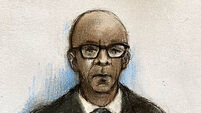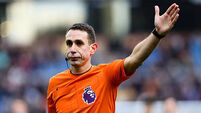Cork City Marathon: Meet the unseen hero of road racing - the course measurer

Travelling the country, you see the signs everywhere. 5k this Sunday. A charity 10k next weekend. Road races taking place in every village in Ireland.
Which begs the obvious, if eventual, question: who measures those courses? And how is it done?
Tom McCormack holds an IAAFA measuring licence and can link the old days, holding a trundle wheel out of the passenger window of a Rolls-Royce to measure a marathon, and the new dispensation, when the measurer is confronted by satnav-wielding questioners after races. But the basic requirements for a course measurer remain the same.
“The first is to have a bike, and after that? You have to have balls of steel to cycle against the traffic.”
McCormack goes back almost 30 years in Irish course measuring. Back in 1990 Liam Hennessy, then secretary of BLE, arranged for an English team, Max Coleby and John Disley, to come and teach their system in Ireland. McCormack organised accommodation and courses for them to teach.
“They assumed I was in charge - I wasn’t, Liam Hennessy was - but they gave me the Grade B automatically. Disley subsequently organised a European test in Dublin, which involved Irish and European measurers, and it worked out very well. Coleby’s report to the IAAF recommended I be given the Grade A qualification. I was lucky.”
So how is a race course measured? Establishing your baseline is the first step.
“The baseline is measured out by a steel tape which is tensioned to ten pounds. The tape must be certified to fifty neutrons at 20 degrees: that 20 degrees is the temperature of the road, not the tape.
“You lay out your baseline, which preferably should be 400 metres. That has to be on a perfectly straight footpath, bicycle lane or road. I have two spots in the Phoenix Park that I know - Chesterfield Avenue is perfectly straight - while I have another on Griffith Avenue and another on the docks. Measurers around the country would have their own spots.”
Back up. What was that about the temperature of the road?
“The temperature’s a major factor. When you check the temperature (of the road), if it’s above 20 degrees then the tape has expanded with the heat, and you take off a couple of centimetres. If it’s extremely cold then you have to add on a couple of centimetres, because the tape contracts in the cold. That 400 metres must be 400 metres exactly. That’s your baseline.
“When that’s measured we put the Jones Counter on the bicycle.”
The Jones Counter is a little box that attaches to the bike, its gears clicking to measure the distance travelled by the bike. Recognised by the IAAF as the official measuring device for road races, it’s a vital mechanism the measurer uses as he cycles the 400 metres of the baseline. From that 400 metres he calibrates the counter to work out how many digits on it correspond to 1 kilometre or 1 mile.
“If you’re doing a marathon, that’s 42 kilometres, so you then cycle the shortest possible route the athletes can take, and you take the Jones counter measures that as you go.”
Then there’s the Short Course Prevention Factor.
“It’s necessary to multiply the final figure by 1.001 in order to add in one metre to the Km figure. That’s the Short Course Prevention Factor, which allows for variations which might arise during the measuring exercise - pedestrians, dogs, motorists, etc. - and also ensures the course is at least the stated distance in the event of a super-fast time or world record being set.
“It doesn’t matter if it is a 5k or a marathon, the method is the same. You cycle the base line, then you recalibrate your counter and go again - the first figure was your working figure, to which you add the post-calibration figure. Divide by two and the difference between the working figure and the post figure is calculated to metres. That’s for each Km of the course, so for a 5Km race it’s multiplied by 5 and so on.”

Experience has taught McCormack some valuable practical lessons - “I have a small board set on the handlebar of the bike and can do my calculations there. When I give courses I tell measurers to have a solid notebook, to keep their records so they can refer back if there’s a query - you’re always backed up.
“It’s a simple process once you get your baseline correct. That’s absolutely critical. If you’re a few inches out on that initial 400 metres, multiply that for as long as you’re using that measurement. That’s where the errors come in. Those ‘inches out’ will repeat over and over again, and the entire measurement is off.” That’s the theory. The practice can be challenging.
“In the recent (Dublin) mini-marathon the course was changed, so now it’s against the flow of traffic, which can be a nightmare to measure. Going with the traffic is half a nightmare, but going against it . . . the gardaí simply say, ‘I’m not going with you driving against the flow of the traffic’.
“You’d measure it, then, at 6 am on a Sunday morning, when traffic is usually light, so you start off cycling like blazes, and when a car comes against you, then you simply stop. The counter only works when you’re working.
“When there’s a break in the traffic then you simply continue on the line you need to take. It can be done, but it’s getting increasingly dangerous because traffic levels are increasing all the time.”
McCormack says the bike is necessary because it’s more accurate. Simple as that.
“The first marathon I did was a Dublin County Board marathon, and a friend of mine had a Rolls-Royce, so we measured it with me sitting next to him and holding a trundle wheel out the window. “We were following the line of traffic completely, not taking the shortest possible route that an athlete can take. For instance, going around a wide bend - if you go too wide then your measurement will be inaccurate.
“Nowadays you have lads with Garmin watches saying, ‘according to my watch we’re 50 metres short’ or whatever. But if you look at the recent Virgin race in London, for instance, there were over 5,000 runners. The guy running on the shortest possible route in that is running accurately, but the guy next to him isn’t, and the guy with six people between him and the guy running accurately certainly isn’t.
“And if he’s looking at his Garmin watch, he might notice that as he passes certain buildings his watch is missing the satellite signal for the satnav - so there’s a miss on the watch.”
That’s less of a problem now because more people “are beginning to see reason”, he says: “At the end of a race you have this person saying ‘the race is 50 metres short’ but someone over here says ‘no, according to my watch it’s 40 metres short’. Different readings.
“It was a headache initially, trying to justify ourselves, but then we just said, ‘we’re right, they’re wrong’.
That’s not to say the measurers can’t be wrong on occasion. McCormack can point to an early hiccup.
“The first race I measured was just after we’d learned this procedure, so I said I’d measure this 10k in Belfield.
“I calibrated my counter - and wrote the wrong figure down, so the race was too long. There were articles suggesting we contact John Walsh in Ballycotton, who had his own system, and when I did, that’s when I discovered the Jones counter.
“There’s always a possibility you can make a mistake, which I did in the case of Belfield, but that wasn’t a flaw in the technique - it was a mistake in transcribing. And in courses I always start with that. That as much as you think you know, there’s another aspect to it apart from measuring - there are the calculations that have to be made, and you must pay attention.”
That’s not a cliche. McCormack knows how tricky the job can be.
“Doing a marathon, the job should be done in five to six hours, all going well. I measured a half-marathon recently and had to cycle up the Dublin quays, and while everyone thinks the Liffey is a straight line, it isn’t. It zig-zags.
“Crossing a line of cars, one of them didn’t give me ground, and knocked me off. Measurement cancelled.”
He went the following Sunday and took more care (“I didn’t get knocked off the bike, anyway,”). Got it done.
For AAI races the course must be measured by a AAI recognised measurer to be permitted, and if it has an AAI permit it’s covered by AAI insurance, he says, but many race organisers don’t bother to do so.
“A local charity may decide to run a 5K for a few bob and won’t get it measured because there are expenses involved in bringing a measurer in. That expense puts organisers off, because they don’t all have a thousand runners taking part to cover expenses.
“If you have an official permit you’d hope the gardaí would look kindly on giving the race permission, but the measurer has another responsibility - ensuring it’s a safe course. If you’re working with half a road, then you must ensure the road is coned in the centre to keep athletes away from the traffic.
“It’s the measurer’s responsibility to ensure matters like that are looked after. There’s often controversy because athletes want to judge their PB, and the course determines that.”
Some courses are better for the PB than others.
“The athlete may be on top form but there might be a severe hill in the course that affects their PB, for instance. Smart athletes pick out fast courses - flat courses, in other words.
“The London Marathon is known as a fast course, for instance, whereas the Dublin Marathon, you have a climb out of the city into the Phoenix Park, a climb up the Crumlin Road . . . a really fast time in Dublin is a very good time.
“In a marathon course you can have a hill going up, but the maximum allowed coming down is a fall of 1 metre per kilometre, so they don’t get up a head of steam. Promoters want fast times, because fast times attract more entrants, obviously.”
In his courses on measuring, McCormack likes former athletes.
“If you get teachers or engineers or mathematicians on the courses . . .” - a laugh - “I’d be basic in my approach. I start with the bottom line and teach to my level, but sometimes a guy on the course will put the hand up and say, ‘there’s a better way . . . ‘
“In fairness, sometimes that’s great, and it might be something I could use the next time.”
Still learning, then, after all these years.












